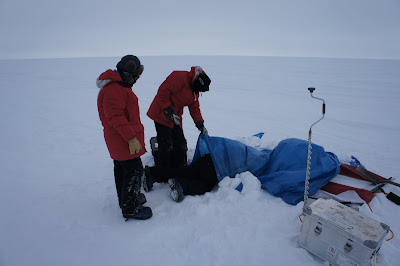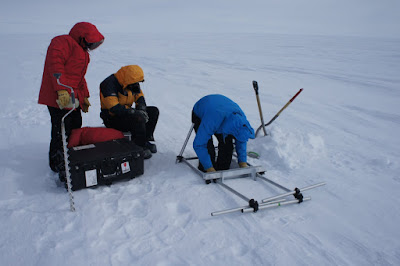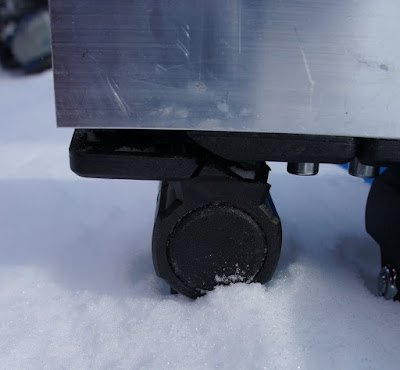Original post, called in on January 14, 2011. Transcription thanks to Jonathan Beall.
(Sorry it’s taking me so long to put these up, by the way. Believe it or not, adding photos is the most time-consuming part of the process. Maybe I need to work on my methods.)
“Well, the wind is blowing just about as hard today as it did yesterday, but a helpful meteorologist at McMurdo told us that things are only going to get worse over the weekend, so we figured we had better make the most of it. We headed out on snowmobiles into the ice field to choose a new place to take measurements. We can’t actually make albedo measurements when the wind is this strong because blowing snow interferes with them. But we can select good sites to measure, which saves us time later on. Once we get a calm enough day, we’ll jump on our snow machines and spend it running around to different sites with our albedo measuring device. (I made a post about this instrument, the ASD, some time last year. If I had internet access, I’d link to it, but since I don’t perhaps some helpful person will do so in the comments. [A couple mentions, but I don’t see a post all about it.–Jonathan] [He’s right, I misremembered. Sorry! I’ll have to make one. — me]) We marked a site and took an ice core or three, and then went home for lunch.
In the afternoon, we tested out Martin’s device for measuring snow surface areas, which he made himself. It’s a sort of framework meant to be inserted into the snow. Then you dig the snow out of it to make a pit and take a picture of the wall of the pit using near-infrared light.
Snow grains of different sizes reflect different amounts of near-infrared light. They reflect different amounts of other light too, but the differences are easier to see in the near infrared. It’s a little bit of a simplification to say that the amount of reflected light tells you the grain size. It really tells you the surface area, because it tells you how many surfaces the light has bounced off before it reaches the camera. Once you’ve taken that picture, you dig a second one, leaving just a thin wall of snow, and shine a light through that wall to see how much gets through. This lets you calculate the density of the snow.
It also happens to be beautiful. The different layers in the snow make delicate strips, shading from light to dark, depending on the time of year they were deposited, the weather when the snow fell, and various other things.
So, that’s what we were trying to do. However, things didn’t go quite as planned. We soon discovered that the snow here is much harder than the snow in the Alps, and we couldn’t insert the frame without damaging the snow we wanted to measure. Finally, we figured out that we could drill holes in the snow with our auger, which allowed us to set up the device with relative ease, although it still took a lot of hard shoveling to dig out the pit. And then, at some point, as we tried to get everything set up, we made the unwelcome discovery that Martin’s supplier for frame connectors had been somewhat mistaken about their tolerance for cold, and the frame snapped in half.
And of course, remember, that we’re doing all this in twenty-knot winds. But we finally managed to get everything set up, we took our measurements, and we went home feeling like scientific heroes. We got to take an item off the list of tasks that Ruschle wrote up for us, so we’re all feeling pretty good about ourselves.

The wind meant that we had to put a tarp over the site to prevent everything from being covered with fine drifted snow.
It’s supposed to snow tonight. It should be an interesting weekend. Until then, ciao.”


